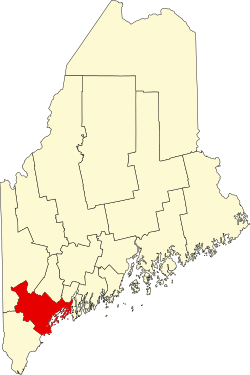Casco, Maine | |
|---|---|
 Casco village from the air with Pleasant Lake in the background | |
 Location in Cumberland County and the state of Maine. | |
| Coordinates: 44°00′24″N70°31′22″W / 44.00667°N 70.52278°W (North Casco) | |
| Country | |
| State | |
| County | Cumberland |
| Incorporated | 1841 |
| Villages | Casco Cook Mills Crescent Lake Pike Corner South Casco |
| Area | |
• Total | 38.01 sq mi (98.45 km2) |
| • Land | 31.24 sq mi (80.91 km2) |
| • Water | 6.77 sq mi (17.53 km2) |
| Elevation | 545 ft (166 m) |
| Population (2020) | |
• Total | 3,646 |
| • Density | 117/sq mi (45.1/km2) |
| Time zone | UTC−5 (Eastern (EST)) |
| • Summer (DST) | UTC−4 (EDT) |
| ZIP Codes | 04015 (Casco) 04077 (South Casco) |
| Area code | 207 |
| FIPS code | 23-11125 |
| GNIS feature ID | 0582395 |
| Website | cascomaine.org |
Casco is a town in Cumberland County, Maine, United States. Casco is included in the Lewiston-Auburn, Maine metropolitan New England city and town area. The population was 3,646 at the 2020 census. [2] Casco includes the villages of Casco, South Casco and Cook Mills. The town borders the east shore of Sebago Lake, and is home to part of Sebago Lake State Park. Casco is part of the Portland – South Portland – Biddeford, Maine metropolitan statistical area. Casco is just under 30 miles (48 km) from downtown Portland.
Contents
- History
- Geography
- Demographics
- 2010 census
- 2000 census
- Transportation
- Sites of interest
- Notable people
- References
- External links
Casco is the home of "Casco Days", an annual community fair which takes place in Casco Days Park, always on the last Saturday in July. [3]



